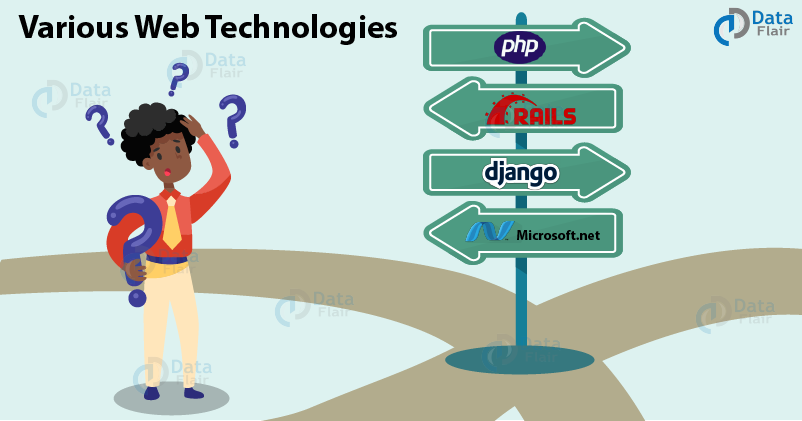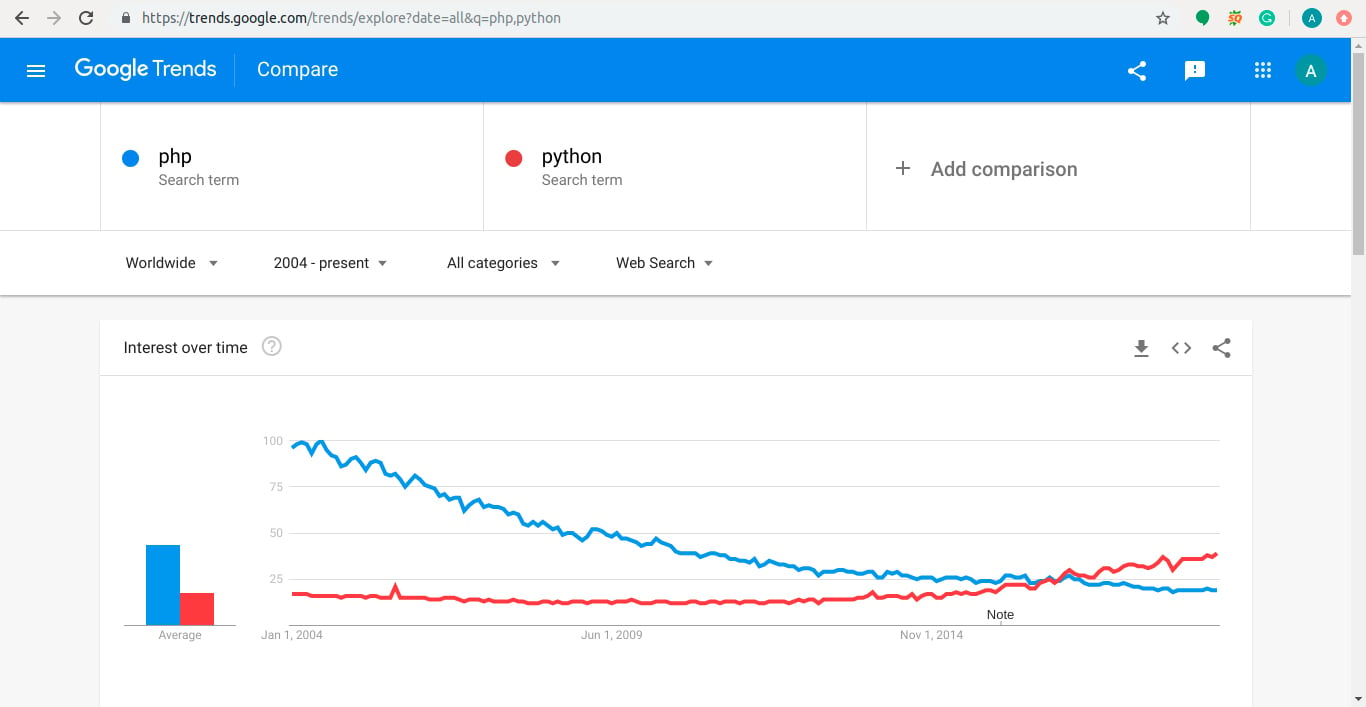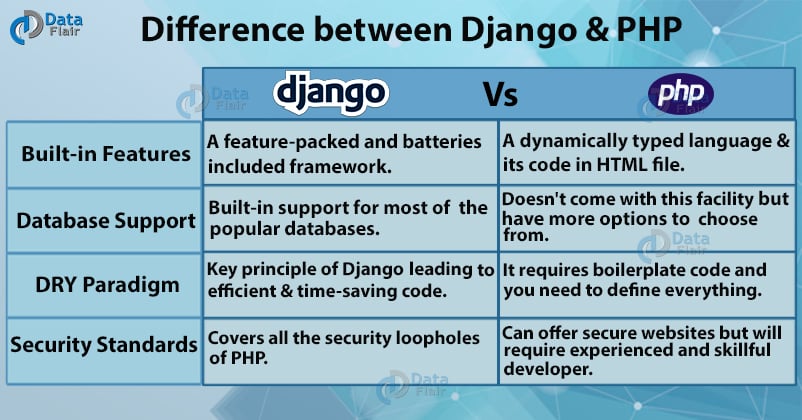Django vs PHP – Clearing the confusion of Web Developers
Python course with 57 real-time projects - Learn Python
FREE Online Courses: Dive into Knowledge for Free. Learn More!
Django vs PHP – Web development is booming with technologies right now. There are so many options to choose from. So many technologies for frontend and backend. It gets kind of difficult for developers to choose from so many options. Let us help you out there.
This article explains the difference between PHP and Django framework. We will discuss the pros and cons of both technologies. After that, you can decide the technology you want to learn according to your requirements.
Django vs PHP – Which is the better one?
A brief introduction – Backend Technologies
Django and PHP both are well-tested technologies. They are used to develop the backend part of a website. Backend is another half of any website. It plays a key role in handling user requests and responses. Backend technology has to deal with database operations, serving requests, etc.
Both PHP and Django framework are quite capable of handling these tasks.
- Django Framework
Django is a high-level Python framework which provides support for web apps. It comes pre-installed with many important packages. These packages ensure fast and efficient backend for websites. It was developed in 2003 by web programmers Adrian Holovaty and Simon Willison.
- PHP
PHP is a server-side scripting language. It is an acronym for hypertext preprocessor. PHP can be directly embedded in HTML documents. Almost all the server can compile and run PHP. It is currently the most predominant backend technology in the market.
Now that we know what we are discussing. Let’s get started.
The Problem Statement
Both the PHP and Django framework came into existence because they solved a problem. PHP is a decade older than Django and thus solve different issues.
- The problem solved by PHP
PHP’s first use was for personal purposes. The first implementation of PHP is in CGI files by its developer Rasmus Lerdorf in 1994.
It was to track the visits to his personal website. Thus, it was first called personal home page tools. PHP existed as C files in beginning. Later on, he added more functions in the form of CGI files. Those functions were in-demand on the internet at that time. This made PHP popular among developers.
As its userbase grew, more transformations came and it changed to a full-fledged programming language.
- The problem solved by Django
Django was born in a newsroom environment. The philosophy of Django is to do web-development rapidly and efficiently. It comes with built-in packages which enable connection with databases, managing urls, etc.
Django allows for easier integration with multiple components required for the backend. Django also comes with in-built security measures.
Okay, we now understand that both technologies solved the problem of their times.
Python vs PHP
Python has been emerging as an alternative to PHP from its recent developments. Still, the number of websites using PHP far exceeds that used by Python. Both languages are extensively used on the web.
Python is a very powerful language used for almost all verticals of development; Machine learning, web development, desktop applications, etc. Its wide range of applications makes it more attractive then PHP. Also, Python is comparatively easier to learn.
Currently, it tops the popularity charts in programming languages.
PHP, on the other hand, is decreasing in popularity. It is a language which can be directly embedded into HTML. There are many popular web frameworks based on PHP. Laravel is one of the most famous among them.
So, basically, developers are more Python oriented than ever to PHP. Python is more multi-versed language than PHP. Although PHP has a huge community, Python’s is much bigger.
You can verify it from this image from the Google Trends tool.
The blue is PHP and red is Python. The graph is plotted between 2004 – 2019. As you can see, PHP was all the hype over web back in 2004. Even though, PHP’s not used that much now. Still, the web contains a lot of websites working on PHP.
Well, let’s compare PHP and Django now. This comparison cannot be direct as Django is a framework and PHP is a whole language. I would try my best to compare these two on valid parameters.
Django vs PHP – Difference between Django and PHP
Django is a high-level Python web framework for rapid development of web apps. Since it’s a Python framework so we will be working with python.
Today, developers are more oriented towards learning frameworks. Since they let them develop fast and efficient web applications. PHP also has many frameworks like Laravel, Kohana, Zend, etc. These are also feature-packed but nothing beats Django’s community support.
Both PHP and Django provide a backend to the world’s biggest companies. Product-based companies like Google, Facebook, Instagram prefer Django. Websites like Wikipedia, Tumblr, Yahoo run PHP in the backend.
So, both of these technologies have proven themselves, although, Django is highly scalable in comparison to PHP.
1. Built-in Features
Django is feature-packed and batteries included framework. It has many modules inside it like Django-Admin, Django-Authentication, Django ORM, etc.
There are frameworks like Django REST Framework on top of Django. All these modules are there to help with faster development.
PHP is a dynamically typed language. PHP code can exist in HTML files. The implementation of dynamic pages on the web was first done in PHP. Servers like Apache, Windows Server, and others support PHP natively. But you will need Python on the server first to use Django.
Since it’s developed to resolve common problems of web developers.
2. File Uploading
File uploading in Django is way simpler than in PHP. In Django, we can use the Image field in our forms.py. It will take care of validating and encoding the image. In PHP, you will have to write a bunch of code for the same. It will not check for errors in PHP.
In Django, users can upload same files so that Django automatically names them. In PHP, you would have to write code for the same. While in Django, it automatically associates and stores file on a hard drive. In PHP, the file is first stored in a temporary location.
php.info file contains that fil-info and storage location. Then the file is transferred to the destination URL. This makes the process lengthy and resource consuming. Also, PHP’s implementation is simpler to understand than Django. The language itself can be a bit confusing.
If you are using a framework that’s a different story. Still, Django has a better system for file uploading and management.
3. Built-in Database Support
This is one of the special features of Django. This framework provides built-in support for most of the trending databases. Although most of them are a relational database.
PHP doesn’t come with this facility. Although you have more options to choose from when selecting a database with PHP. It extends the options to NoSQL databases.
Then you will need to write the code for performing queries in PHP. Databases can be difficult to connect with PHP for a beginner. The developer should have experience in SQL or a specific database.
Django makes it easy to use database. It provides such awesome features like migrations, ORM, Querysets, etc. These features will generate everything for application. They will generate SQL code for performing database queries. In Django, you can also version control model changes. It’s a very helpful feature.
It is very easy to make changes in models in Django.
4. DRY Paradigm
DRY, acronym for Don’t Repeat Yourself. This paradigm is key to an efficient and time-saving code. This philosophy is one of the key principles of Django.
PHP requires boilerplate code. That is because you have to define everything. Actually, it is this problem which Django solves.
In PHP, developers have to write all the boilerplate code. The process is the same for every new application they add. This approach is time-consuming and requires experienced developers. Then again you would need a great deal of knowledge to make it secure.
5. Rapid Development
As we discussed in the previous section about Django’s rapid development speed. We will be answering the question; how does it achieve that? Django enables modularity of web application. The framework consists of loosely coupled components. This makes it easier to work on different modules.
The modularity and integration make it perfect to work on by multiple developers. That allows for fast development. Also, no compromises on security or features.
PHP doesn’t give that modularity. Since PHP code resides in HTML, this makes it difficult to maintain for larger projects. So, what works for one file may not work for others. Then there are database connectivity issues too.
Django resolves these issues with built-in apps. Django’s goal is to provide secure web apps which can be rapidly developed.
6. Security Standards
Django has covered any security loopholes that were there in PHP. Actually, PHP is also capable of offering secure websites. But, it would require an experienced and skillful developer to achieve that. Django comes with those issues taken care of. Even beginners can be assured for security loopholes.
That’s the reason industries prefer Django over other frameworks. There is inbuilt support for csrf protection. The built-in authentication framework is very secure using different algorithms to store passwords.
7. Environment Setup
We do need to set up an environment before we can start using these technologies.
Django is a Python framework so we need Python package on the server. Currently, Django 2.2 supports Python 3.5 and above. After installing Python on the server we need to install Django.
So, you need Python installed on your system and then install Django.
All servers provide native support for PHP. So, if you have a server and a web browser you are good to go. You can learn more about the installation of PHP from their documentation.
When using Django on the production environment you need to install a server program. On that server, we install Python and then Django. While for PHP, only the server is necessary.
Django is a bit more complex when needed to set up on production.
8. Project Structure and Syntax
When it comes to syntax, Python is one of the best languages. Django is thus, a delight to develop websites since Python syntax is so easy to read and very logical. PHP is also an easy language but can be confusing to read when compared to Python.
Since Django is a framework you have to make a project as defined by it. Django is seen as monolithic for this reason. This has certain benefits in the industry though.
The structure of applications remains the same for any kind of application. This makes it easier for a developer to understand and work on applications.
Django has a very logical project structure. A Django project is a collection of applications. These applications each have their own particular Models, View layers and Templates. There is no limit on a number of applications.
These applications are interchangeable among other Django projects. This reduces code repetition. This is also the reason for Django’s modularity. Although you will have to understand Django MTV architecture.
PHP allows for diverse development. You can make your own systems and CRUD operations of how they should work. PHP is embedded directly in HTML. These HTML files contain PHP code.
You can use PHP as easily by just writing code in tags <?php … ?>. This will implement code from PHP to HTML.
Then there are individual PHP files running things in the background. PHP has its own benefits of diverse design. This approach does not allow for interchangeable web applications though.
9. Documentation
Both technologies are well documented. Documentation is a very important factor when learning any technology. Both PHP and Django provide very helpful documentation. This makes it easier to learn and fix bugs.
Summary
Both Django and PHP are awesome backend technologies. Both of them have solved major issues of web development. You must have found this Django vs PHP article oriented towards Django. Sorry if anyone’s feelings got hurt. I am here to give an honest comparison of these two technologies.
I have experience with both PHP and Django. And, I love that PHP can be directly embedded in HTML. Also, PHP is runnable on all the servers. You actually don’t have to install anything extra when working on servers. Thus, it is much easier to setup PHP on the server then Django.
Although, as long as I am concerned Django is a way to go now. Frameworks are more beneficial in the long-run for web development.
The difference comes from the development community. Django is actively developed. More and more developers are leaning towards python. PHP is still used for many websites and you may get benefit from it. If you are learning web development from the beginning then I would suggest Django.
It is readily accepted in the industry and is much easier to develop in.
It is very efficient and we have discussed the features of Django, you can check it. Django can be pretty overwhelming with all its features. In the long run, those features will help you a lot.
Now, you should look at this article as features that web development needs today. It’s not for favoring Django. PHP solved problems in the 90s. Django solves problems today. One of the main reasons I did not choose PHP is that its development is stagnant.
For a long time, there are no newer versions of PHP. The case is totally different with Python and Django. Nonetheless, both of these are just tools. If your work gets done then you can use any one of your choice. Thanks for reading everyone. Hope it cleared your confusion among the two technologies.
So, according to you, who is the winner in Django vs PHP? Or, it’s a tie😝. Do share your views in the comment section.
Did you like our efforts? If Yes, please give DataFlair 5 Stars on Google





Seriously are you comparing php vs Django?, PHP is a language and Django is a framework, please try to understand the difference between them before to compare, let try to compare django vs laravel or Symfony instead
He is comparing programing with PHP, and programing using the framewok Django, regardless what they are.
this is just rediculous comparison..
symfony php framwork has almost the same features like django and even more
comparison of php to python or symfony/laravel to django would be ok…
but framwork to pure lanaguage???
Great article, cleared many of my doubts before starting a new project from scratch. Thanks!
Aside from how ridiculous comparing programming language with a framework is, there are a few untrue statements here. Basically, just how one should expect, yes – getting things done in Django is faster. But the moment you need anything more than standard solutions, things get messy. My team has lost days for uploaded files handling and serving – solving problems that simply do not exist in PHP, where you have to define everything from scratch – and it takes you much LESS time than implementing custom functionalities in existing framework.
About built-in database support – I think PDO existed in PHP for about ten years before this article was first posted. PHP does not offer built in “database model” support though.
About Security Standards – it’s highly irresponsible to assume Django “takes care of everything”. Most existing Django applications do have CSS vulnerability right now, probably because Django developers assume they don’t need to care. I find it much easier to provide secure software when I can exactly identify vulnerabilities and cover them. That’s why before I started working in Django I read the documentation dozen of times. That’s basically not something that developers usually do. Remember to take a look at the source code of every python app you’re using as well, good luck.
About DRY Paradigm – it’s possible to create DRY code in PHP, most developers repeat themselves no matter what language or framework they’re using.
I’ve worked with PHP for 12 years and with Django for about 8, I could really go on, but it all really comes to one simple, unappreciated fact: using Django or PHP does not make you better or worse developer.
Good